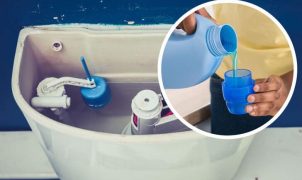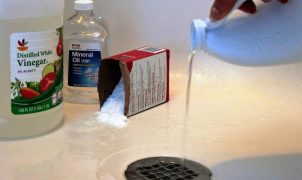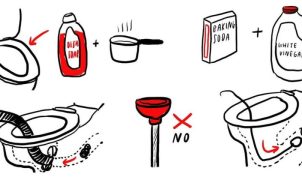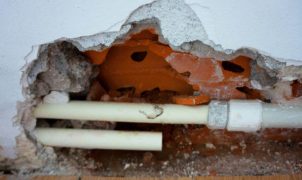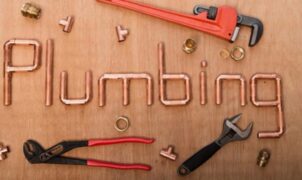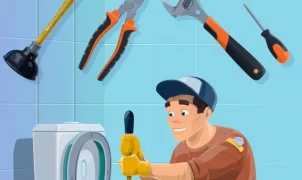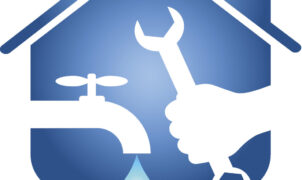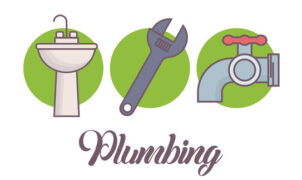Toilet blockage is a problem no one wants to encounter, especially when you have guests visiting or urgently need to use it. However, this is a common situation in daily life. Fortunately, there are many ways to deal with a clogged toilet that you can do yourself at home without the need for a plumber’s assistance. Below are 18 methods to deal with a clogged toilet that you can apply to solve this problem quickly and easily.
1. Signs of a Clogged Toilet
Most households in Vietnam have switched to using flush toilets instead of traditional pit latrines. Although convenient and more hygienic, they often encounter blockages that significantly affect daily life. We can easily identify a clogged toilet through the following signs:
1.1. Water in the toilet bowl does not go down or drains very slowly.
This is the most obvious sign that your toilet is clogged. Objects trapped inside the toilet bowl hinder the free flow of water, causing it to drain very slowly. If the object is large and blocks the drain pipe, the water will almost stop flowing down. Continuous flushing may cause water to overflow onto the bathroom floor.
1.2. Foul odor emanating from the toilet bowl or drain pipe.
When the toilet is clogged, waste material is not pushed down into the septic tank but instead gets trapped in the toilet bowl and drain pipes, causing a foul smell. If left untreated, this condition can attract insects, mosquitoes, and pose health risks.
1.3. Strange noises from the drain pipe when flushing the toilet.
You may notice unusual sounds like gurgling or other strange noises when flushing the toilet. This is one of the important signs that your toilet is experiencing a problem and needs prompt attention.
1.4. Water splashing up from the toilet bowl.
This phenomenon is often encountered in residential areas or high-rise buildings that share a common water drainage system and septic tank. If one toilet has a problem, it can affect the others nearby. That’s why you might see water splashing up from toilets in shopping malls or residential areas.
2. Common Causes of Toilet Clogs
There are many reasons for toilet blockages. The most common ones include:
- Flushing too much toilet paper, especially large wads.
- Pouring grease, excess food, or non-biodegradable substances into the toilet.
- Insufficient flushing force or water to push waste through the drainage system.
- Accidental dropping of objects by children or family members into the toilet.
- Incorrect toilet installation or improper techniques.
- Full septic tank.
Understanding the root causes of toilet blockages will help us apply the right and effective solutions to prevent this problem from recurring in the future.

3. Consequences of a Clogged Toilet
In addition to disrupting the daily lives of household members, a clogged toilet can cause several other challenging issues:
- If toilet water overflows onto the floor, it can lead to pollution and unsanitary conditions, affecting mobility.
- A clogged toilet may force people to hold their urine or feces. Prolonged discomfort can have negative effects on the kidneys and digestive system.
- Toilet blockages create favorable conditions for bacteria and viruses to breed, posing risks of skin, respiratory, and digestive diseases.
- Unpleasant odors can be pervasive, especially for pregnant women, leading to nausea and vomiting, or even premature birth.
- Accumulated waste materials in the drainage pipes, especially hard or sharp objects, can damage the plumbing system, resulting in additional repair and construction costs.
Due to these serious consequences, it’s essential to understand the causes and address toilet blockages as soon as possible to avoid unwanted risks.
4. 18 Simple Tips to Unclog a Toilet at Home
Except for cases where an object falls in, typically, your toilet won’t clog immediately. Before it becomes completely blocked, the toilet may still flush, but the water flow will be slower, accompanied by strange noises. However, we often pay little attention to these signs and continue to use the toilet as usual. This negligence exacerbates the clogging issue.
Learning from experience, try to address the problem as soon as you notice any signs of toilet clogging. Below are 18 simple tips to unclog a toilet that you can apply at home to prevent toilet blockages.
Some notes before starting:
- When the toilet is clogged, you should only close the main door to prevent odors from escaping. However, it’s advisable to open windows or turn on a ventilation fan to avoid the bathroom becoming stuffy, fostering harmful bacteria.
- Before applying any of the following methods, make sure to wear protective gear such as a raincoat, mask, gloves, and tie your hair up high to avoid dirt splashing onto your body.
- If there are signs of toilet overflow, place old towels or cloths on the bathroom floor to absorb water and prevent it from spreading outside.
Method 1: Unclogging the toilet with hot water
A more cost-effective method than ice cubes is unclogging the toilet with hot water. This method is especially effective when the toilet is clogged due to accidentally flushing too much toilet paper or waste. The hot water will soften the paper, making it easier to push through the drainage system. Here’s how to do it:
Step 1: Boil a large pot of water on the stove.
Step 2: Wait until the water reaches a rolling boil.
Step 3: Carefully pour the hot water into the toilet bowl from a height of 30-40cm.
Step 4: Wait for about 5-10 minutes to let the hot water work on softening the paper.
Step 5: Flush the toilet to see if the clog has been removed. If the water drains smoothly, the blockage is likely cleared.
Method 2: Using a toilet plunger
The toilet plunger is an essential tool in every household, especially in cases of toilet blockage. Using a plunger to clear a clogged toilet is a simple and effective method that anyone can do at home. Here’s how to use it properly:
Step 1: Prepare a toilet plunger. If you don’t have one, you can buy it at any household goods store or supermarket.
Step 2: Fill the toilet bowl with enough water to cover the rubber part of the plunger. If there is not enough water in the toilet bowl, add some water from the bucket to increase the pressure when plunging.
Step 3: Place the plunger over the toilet drain hole and press down firmly to create a tight seal.
Step 4: Pump the plunger up and down vigorously for about 20-30 seconds. Keep the plunger submerged in water to maintain suction.
Step 5: Lift the plunger and flush the toilet to see if the blockage has been cleared. If necessary, repeat the process several times until the toilet drains smoothly.
Method 3: Using a plumbing snake
If the toilet is still clogged after using a plunger, you can try using a plumbing snake to remove the blockage. A plumbing snake, also known as a drain auger or toilet jack, is a long, flexible tool designed to reach deep into the toilet drain pipe and dislodge clogs. Here’s how to use it:
Step 1: Prepare a plumbing snake. You can buy it at any hardware store or rent it from a tool rental shop.
Step 2: Insert the end of the plumbing snake into the toilet drain hole.
Step 3: Rotate the handle clockwise while pushing the snake further into the drain pipe. Continue rotating and pushing until you feel resistance or hear a scraping sound, indicating that the snake has reached the clog.
Step 4: Once you’ve reached the clog, rotate the handle counterclockwise to dislodge the blockage. You may need to push and pull the snake several times to break up the clog.
Step 5: Pull the snake out of the drain pipe and flush the toilet to see if the blockage has been cleared. If necessary, repeat the process several times until the toilet drains smoothly.
Method 4: Using a wire hanger
If you don’t have a plumbing snake on hand, you can try using a wire hanger to unclog the toilet. A wire hanger is a simple and readily available tool that can be used to reach into the toilet drain pipe and dislodge clogs. Here’s how to do it:
Step 1: Straighten a wire coat hanger to form a long, straight wire.
Step 2: Bend one end of the wire to form a small hook.
Step 3: Insert the hooked end of the wire into the toilet drain hole.
Step 4: Wiggle the wire around and push it further into the drain pipe until you feel resistance or hear a scraping sound, indicating that the wire has reached the clog.
Step 5: Once you’ve reached the clog, use a twisting motion to break up the blockage and pull it out of the drain pipe.
Step 6: Flush the toilet to see if the blockage has been cleared. If necessary, repeat the process several times until the toilet drains smoothly.
Method 5: Using dish soap and hot water
Dish soap is a versatile household item that can be used for more than just washing dishes. It can also help to unclog a toilet when combined with hot water. The dish soap acts as a lubricant, allowing the clog to slide through the drainage system more easily. Here’s how to do it:
Step 1: Squirt a generous amount of dish soap into the toilet bowl.
Step 2: Boil a large pot of water on the stove.
Step 3: Carefully pour the hot water into the toilet bowl from a height of 30-40cm.
Step 4: Wait for about 5-10 minutes to let the dish soap and hot water work on softening the clog.
Step 5: Flush the toilet to see if the blockage has been cleared. If necessary, repeat the process several times until the toilet drains smoothly.
Method 6: Using baking soda and vinegar
Baking soda and vinegar are two common household items that can be used to unclog a toilet naturally. When combined, they create a chemical reaction that helps to break up stubborn clogs and clear the drainage system. Here’s how to do it:
Step 1: Pour 1 cup of baking soda into the toilet bowl.
Step 2: Pour 1 cup of vinegar into the toilet bowl.
Step 3: Wait for about 30 minutes to let the baking soda and vinegar react and break up the clog.
Step 4: Flush the toilet to see if the blockage has been cleared. If necessary, repeat the process several times until the toilet drains smoothly.
Method 7: Using a wet/dry vacuum cleaner
If you have a wet/dry vacuum cleaner at home, you can use it to unclog a toilet quickly and effectively. The vacuum cleaner creates suction that can help to dislodge stubborn clogs and clear the drainage system. Here’s how to do it:
Step 1: Set the wet/dry vacuum cleaner to the wet setting.
Step 2: Place the vacuum cleaner hose into the toilet drain hole and create a tight seal.
Step 3: Turn on the vacuum cleaner and let it run for a few minutes to create suction.
Step 4: Once you feel resistance or hear a sucking sound, indicating that the vacuum cleaner has dislodged the clog, turn it off.
Step 5: Remove the vacuum cleaner hose and flush the toilet to see if the blockage has been cleared. If necessary, repeat the process several times until the toilet drains smoothly.
Method 8: Using a chemical drain cleaner
If none of the above methods work, you can try using a chemical drain cleaner to unclog the toilet. Chemical drain cleaners are strong and can dissolve stubborn clogs quickly, but they can also damage the plumbing system if used incorrectly. Here’s how to use them safely:
Step 1: Put on protective gear such as gloves and a mask to protect yourself from the chemicals.
Step 2: Pour the recommended amount of chemical drain cleaner into the toilet bowl.
Step 3: Wait for the recommended amount of time as indicated on the product label. Be sure to follow the manufacturer’s instructions carefully.
Step 4: Flush the toilet to see if the blockage has been cleared. If necessary, repeat the process several times until the toilet drains smoothly.
Method 9: Using a toilet auger
If you’re still having trouble unclogging the toilet, you can try using a toilet auger, also known as a closet auger or water closet auger. A toilet auger is a specialized plumbing tool designed specifically for clearing toilet clogs. Here’s how to use it:
Step 1: Prepare a toilet auger. You can buy it at any hardware store or rent it from a tool rental shop.
Step 2: Extend the auger shaft by turning the handle counterclockwise.
Step 3: Insert the end of the auger into the toilet drain hole.
Step 4: Rotate the handle clockwise while pushing the auger further into the drain pipe. Continue rotating and pushing until you feel resistance or hear a scraping sound, indicating that the auger has reached the clog.
Step 5: Once you’ve reached the clog, rotate the handle counterclockwise to dislodge the blockage. You may need to push and pull the auger several times to break up the clog.
Step 6: Pull the auger out of the drain pipe and flush the toilet to see if the blockage has been cleared. If necessary, repeat the process several times until the toilet drains smoothly.
Method 10: Using toilet drain cleaner tablets
In addition to drain cleaning powder, you can also use toilet drain cleaner tablets to address a clogged toilet. This product has the advantage of being easy to find, relatively inexpensive, easy to use, and highly effective.
However, it’s important to note that toilet drain cleaner tablets work best on organic waste causing the clog, such as sediment buildup, algae, grease, leftover food, hair, or toilet paper.
The process of dealing with a clogged toilet using toilet drain cleaner tablets is relatively simple. Depending on the severity of the blockage, you’ll drop 2-4 tablets into the toilet. It’s best to start with just 2 tablets initially, wait for about 30-60 minutes, and then flush to check. If the clog isn’t cleared, then add the remaining 2 tablets.
Note:
- The optimal temperature for toilet drain cleaner tablets to work is 40-60 degrees Celsius. Therefore, you can pour a bucket of warm water into the toilet before adding the tablets.
- If using 4 tablets doesn’t have any effect, it indicates that the toilet is clogged due to inorganic waste. You’ll need to switch to another method to avoid wasting time and effort.
Method 11: Unclogging a toilet using a plastic bottle
It might sound unbelievable, but a disposable plastic bottle can also be a powerful ally when dealing with a clogged toilet if you can’t contact a plumbing service.
Here’s how to do it:
- Use a 1, 1.5, or 2-liter plastic bottle and fill it about two-thirds full with water.
- Put on gloves, hold the bottle by the neck, and place the bottle’s mouth over the toilet drain hole. Apply continuous pressure by pushing down 5-6 times. The water-filled bottle will act like a plunger, creating pressure to help water flow more forcefully, carrying away any foreign objects.
- Finally, remove the bottle and flush the toilet to check the effectiveness of the unclogging.
Method 12: Hand unclogging
Many people are hesitant about using their hands to deal with a clogged toilet. However, it’s a simple and effective method, especially if you accidentally drop items like toothbrushes or socks into the toilet.
To ensure hygiene, wear a pair of long gloves and reach into the toilet bowl to remove any obstructions. Then, clean the area with antibacterial hand wash.
Method 13: Unclogging a toilet with Coca-Cola
If you’re active on social media or regularly browse through everyday life hacks, you’ve probably come across tips for unclogging toilets or cleaning stains using Coca-Cola. Today, let’s try applying this method to a clogged toilet.
Coca-Cola contains Sodium Bicarbonate (baking soda), which acts as a mild cleaning agent, effectively removing stains. Therefore, it’s commonly used for unclogging and cleaning toilets.
All you need to do is pour a 1.5-liter bottle of Coca-Cola into the toilet bowl and wait for at least 1 hour for the Coca-Cola to break down and clean any dirt or residue. Then flush the toilet to rinse away the debris and check the toilet’s performance.
Method 14: Unclogging a toilet with dishwashing liquid
You may have read articles advising against pouring dishwashing liquid into the toilet because it can kill beneficial bacteria in septic systems, affecting waste decomposition. However, in urgent situations, you can still use dishwashing liquid. Just make sure to use it infrequently, perhaps once a month.
Dishwashing liquid can be used to unclog a toilet because its cleaning properties and viscosity act as a lubricant, helping objects slide more easily down the drain.
Here’s how to do it:
- Pour about 15-20ml of dishwashing liquid into the toilet bowl, then slowly add half a bucket of hot water (60 degrees Celsius).
- Leave it for about 20 minutes and then flush the toilet. You’ll be surprised by the unexpected effectiveness.
Method 15: Using a plunger
Many households nowadays have rubber plungers on hand to use when toilets or drainage pipes are clogged. However, not everyone knows how to effectively use a plunger to unclog a toilet.
Here are detailed instructions:
- First, place the rubber end of the plunger into the toilet bowl. Ensure that the rubber part of the plunger completely surrounds the entire drain pipe, with no gaps. If there’s no water in the toilet, add some to cover the rubber part of the plunger.
- Next, use force to push the plunger up and down vigorously. This will create pressure on the blocked section. The high pressure will push waste or foreign objects trapped in the toilet bowl down into the drain.
- Depending on the severity of the blockage, the plunger may work quickly or take a bit longer to be effective. It’s best to repeat the process 2-3 times until the toilet is completely unclogged.
Method 16: Using drain cleaning stickers
Instead of struggling with adhesive tape or plastic wrap on the toilet, you can use a simple yet effective alternative: drain cleaning stickers.
These stickers are cleverly designed to cover the entire mouth of the toilet bowl without leaving any gaps, helping users save time and effort when unclogging a toilet.
Here’s how to do it:
- Step 1: Use a dry cloth to wipe away any water on the rim of the toilet bowl.
- Step 2: Peel off the protective plastic layer from the bottom of the drain cleaning sticker, then stick the sticker onto the toilet bowl rim, ensuring it adheres tightly and covers the entire rim.
- Step 3: Flush the toilet to fill the sticker with water. Then, use both hands to press gently several times to create water pressure, helping waste and foreign objects inside the bowl to flow down into the sewer.
- Step 4: Remove the drain cleaning sticker and flush the toilet to check.
Method 17: Unclogging a toilet using a drain gun
Unlike high-pressure hoses, drain guns are specially designed to deal with clogged toilets, drains, or kitchen sinks. If your household frequently encounters these issues, you may consider purchasing a drain gun for convenient use when needed.
A drain gun uses compressed air to generate strong thrust, quickly pushing away any waste causing the blockage in the toilet, ensuring fast, safe, and cost-effective unclogging.
Here’s how to do it:
- Step 1: Choose the appropriate nozzle (in this case, the nozzle for unclogging toilets) to attach to the drain gun’s mouthpiece. Attach the pump lock to the air intake valve located on the top handle of the gun.
- Step 2: Pump air into the gun while observing the pressure gauge to determine the required pumping pressure. Typically, for unclogging toilets, it’s around 4-5 Bar, while for kitchen sinks or water pipes, it’s 2 Bar, and for washbasins, it’s 3 Bar. These are the manufacturer’s recommended safe pressure levels.
- Step 3: Squeeze the trigger on the handle of the drain gun. The air inside the gun will be released forcefully, creating pressure that helps dislodge any debris or foreign objects causing the blockage.
- Step 4: Remove the drain gun and flush the toilet to check the results. You may need to repeat the process 2-3 times if the toilet remains clogged.
Method 18: Unclogging a toilet using eels or catfish
Eels, catfish, or other similar fish are used to unclog toilets because they can easily navigate through narrow pipes and can push any debris directly down. Choose healthy fish and when placing them in the toilet, make sure their heads are facing downwards.
However, it’s important to use caution with this toilet unclogging method. Some toilets are specially designed, making it impossible for catfish or eels to move. Be careful not to inadvertently encounter counterproductive effects with this method.
Cre: gobe

